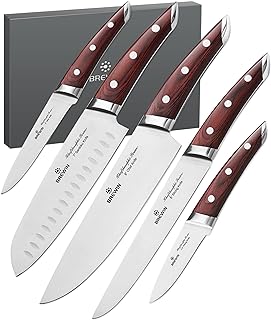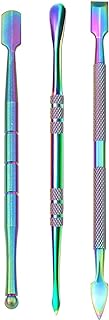5 important factors worth considering when looking for the best chef knives professional
When it comes to cooking, having a good chef’s knife is really important. A high-quality chef’s knife can make a big difference in your experience in the kitchen, taking your cooking skills to the next level. There are a few important things to think about when choosing a chef’s knife, like the material of the blade, how sharp it is, the design of the handle, and how balanced the weight is. Picking the right knife can help you cook more accurately and efficiently, and make your time in the kitchen more enjoyable. It’s crucial to choose a chef’s knife that fits your needs and preferences perfectly.
See our guide to the best chef knives professional.
Blade material
When it comes to choosing the right material for professional chef knives, there are many options available in the market. One popular choice is high-carbon stainless steel, which combines the durability of stainless steel with the sharpness and edge retention of high-carbon steel. This makes it great for chefs who need precise cutting and long-lasting sharpness. High-carbon stainless steel blades don’t rust or corrode, meaning they’ll stay high-quality even with frequent use in a busy kitchen.
Alternatively, some chefs prefer Damascus steel blades for their unique and beautiful looks. These blades have wavy patterns created by layering different types of steel. While they may not stay sharp as long as high-carbon stainless steel, their beauty and history make them appealing to chefs who value craftsmanship and tradition. When choosing a blade material for professional chef knives, it ultimately comes down to personal preference and what the chef needs. Each material has its own advantages, so think about what’s important to you in terms of sharpness, durability, maintenance, and aesthetics to make the best decision.
Blade shape and size
When choosing a professional chef’s knife, it’s important to consider the shape and size of the blade. The shape of the blade affects how well the knife can be used for different cutting tasks. For example, a French chef’s knife with a curved blade is great for chopping herbs and vegetables easily. On the other hand, a Japanese Nakiri blade with a straight edge is perfect for slicing ingredients like sashimi with precision. The size of the blade also matters, impacting how comfortable and in control you feel when using the knife. A longer blade gives you more leverage for cutting larger pieces of meat or vegetables. A shorter blade, on the other hand, allows for better agility and maneuverability, especially in tight spaces. Finding the right combination of blade shape and size that suits your cooking style will enhance your experience in the kitchen.
Choosing the right blade shape and size is essential for professional chefs, as it can greatly improve the precision and skill in your cooking. Understanding the different characteristics of each blade style helps you choose the best knife for your specific needs and preferences. Trying out various blade shapes and sizes allows you to find the perfect balance between versatility and comfort, empowering you to be more creative in the kitchen. Whether you prefer a sturdy German-style blade for tough jobs or a nimble Japanese blade for delicate cuts, the key is to find a knife that feels like an extension of your hand. In the world of professional chef knives, the blade shape and size can make a huge difference in creating a delicious meal versus a culinary masterpiece.
Handle ergonomic design
When buying professional chef knives, it’s important to consider the design of the handle. A good handle can make a big difference in how easy and comfortable it is to use the knife. Picture yourself cutting and slicing for hours with a handle that doesn’t fit well in your hand – it can lead to pain, tiredness, and even injury. A handle that is shaped for comfort and made of high-quality materials can improve your grip and control, making cooking more enjoyable.
Choosing chef knives with handles designed for comfort is not just about how it feels – it also shows the care and skill put into making a high-quality tool. The handle is the link between you and the blade, and a good handle can improve the knife’s balance and stability. A comfortable handle can also reduce strain on your wrist and hand, making it easier to do repetitive cutting tasks and lowering the risk of future injuries. In short, a well-designed handle is not just a luxury – it’s an important part of improving your cooking skills and making time in the kitchen more pleasant and efficient.
Balance and weight distribution
When choosing professional chef knives, it’s important to consider more than just sharpness and durability – balance and weight distribution are key factors too. A well-balanced knife can improve control and precision while reducing fatigue during long cooking sessions.
Think about how the weight of the knife affects the way you cut. If a knife is too heavy in the front, it can strain your wrist and forearm, leading to discomfort and affecting your cutting skills. On the other hand, a well-balanced knife allows for smooth, easy cuts, making kitchen tasks more efficient and enjoyable. Finding the right balance in a chef’s knife isn’t just a matter of preference – it can greatly enhance your cooking experience and elevate your culinary creations.
Maintenance and sharpening requirements
When buying professional chef knives, it’s important to remember the maintenance and sharpening they need. It’s not just about investing in good knives – you also have to take care of them to make sure they last and work well. Cleaning and drying the blades after each use helps prevent rust and keeps them sharp. Sharpening your knives regularly is crucial for precision and efficiency in the kitchen. A sharp knife not only improves your cooking skills but also makes tasks easier and safer. By keeping up with maintenance and sharpening, you show dedication to your craft and ensure your investment in professional chef knives pays off in the long run.
Ignoring the maintenance and sharpening of your chef knives can make cooking harder. Dull blades not only affect the quality of your cuts but can also be dangerous. Learning how to sharpen your knives properly is a skill every chef should have to get the most out of their tools. Having a well-maintained knife set shows professionalism and commitment to cooking. By making maintenance and sharpening a regular part of your kitchen routine, you raise your cooking standards and show respect for your knives. Keep in mind, a chef is only as good as their tools, and a well-maintained knife is essential for cooking well.
Conclusion
In the world of cooking, where precision, skill, and creativity are highly valued, the chef knife is like a secret hero in every kitchen. It’s not just a tool – it’s an expression of a chef’s passion and dedication, reflecting the expertise of those who use it with elegance and precision. A professional chef knife is more than just a utensil; it symbolizes culinary excellence and surpasses mere practicality. Whether you’re a seasoned chef or just love cooking, buying a high-quality professional chef knife is a way to show your dedication to cooking and the pursuit of culinary perfection. Want more info on egf serums, check the best egf serums.

